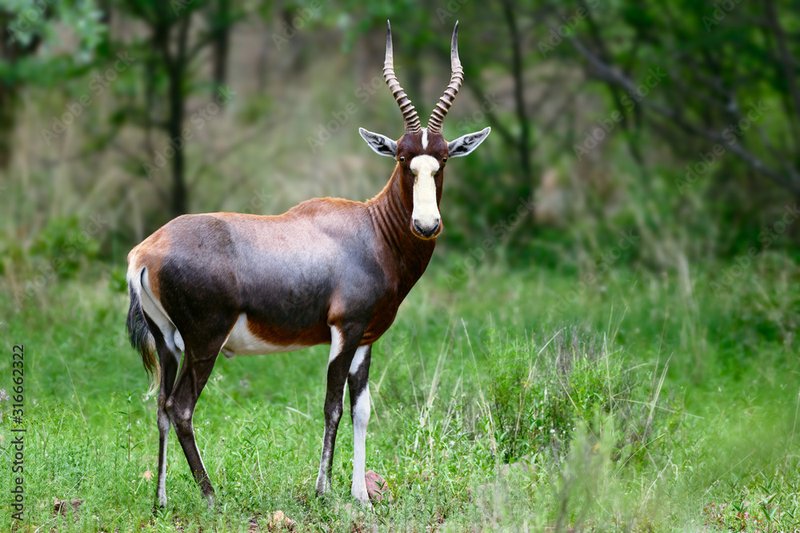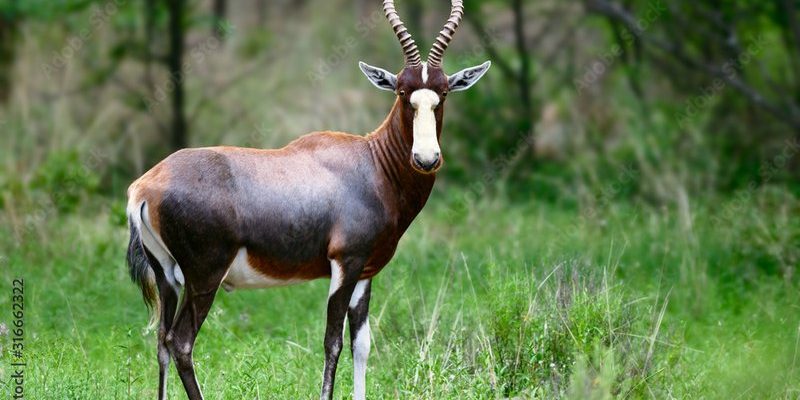
Picture the African savannah, where golden grasses sway in the warm breeze. Amidst this stunning backdrop roams the Blesbok, a beautiful antelope known for its striking appearance and unique behavior. Standing out with its characteristic white blaze on the face, the Blesbok is not just a sight to behold; it’s a fascinating creature that plays an important role in its ecosystem.
These animals may be lesser-known compared to their larger relatives, but they’re definitely worth getting to know. In this article, we’ll explore everything about the Blesbok, from its habitat to its diet, and even some fun facts that might surprise you. So, let’s embark on this journey together and discover what makes the Blesbok such a remarkable animal!
Physical Characteristics
The Blesbok is a medium-sized antelope, with males usually larger than females. Adults can weigh between 90 to 125 pounds, while standing about 3.5 feet tall at the shoulder. The most noticeable feature is the distinctive white blaze that runs down their face, giving them a unique look compared to other antelope species. Their coat is generally brown, often described as having a warm hue that blends beautifully with their savannah surroundings.
Another striking feature is their curved horns, which can grow up to 30 inches long in males. These horns not only serve as a display of dominance during fights with other males but also help them defend against predators. Females, on the other hand, lack horns entirely, which provides them with a different kind of grace.
Additionally, their long legs and slim build are perfectly designed for agility, allowing them to escape predators effectively. The Blesbok’s size, along with its speed of up to 40 miles per hour, ensures that it can navigate its environment swiftly, darting away when danger approaches.
Habitat and Range
Blesboks are native to South Africa, primarily found in open grasslands and savannahs. Their preferred habitats are often characterized by short grasses, which help them graze easily. However, they also thrive in areas where bushes or shrubs are present, providing ample shelter and protection from predators.
In the wild, they can be found in herds, which helps provide safety in numbers against predators like lions and leopards. These herds typically consist of females and their young, while males often remain solitary or join up with other males during the breeding season. It’s fascinating to think about how their social structures play a critical role in their survival.
Over time, the Blesbok population has become a conservation success story. After facing near extinction in the early 20th century due to hunting and habitat loss, conservation efforts have led to a stable resurgence, especially in protected reserves. Today, they occupy much of their original range and are often seen in national parks and private reserves.
Diet and Feeding Habits
As herbivores, Blesboks primarily consume grasses, which make up the majority of their diet. They have a unique way of grazing that allows them to be selective; they tend to favor new shoots and leaves that are rich in nutrients. This selective grazing helps ensure they get the most out of their food, which is crucial for their health and vitality.
You might notice how, during the hottest parts of the day, these antelopes often find shade to rest. This behavior helps them conserve energy and stay hydrated. They are most active during the cooler hours of the morning and late afternoon when they can graze without tiring themselves out too much in the sweltering heat.
Interestingly, Blesboks have adapted well to the nutrient-poor soils of their natural habitats. Their digestive systems are efficient, allowing them to extract and utilize the nutrients from their fibrous diet. This means that even when food is scarce, they can sustain themselves. Isn’t it amazing how nature equips animals with the tools they need to survive?
Behavior and Social Structure
Blesboks are known for their social behavior, often seen in herds that can range from 10 to 30 individuals. These herds are primarily composed of females and their young, while adult males tend to be solitary or form small bachelor groups. Social structures play a vital role in their survival, as they rely on one another for protection from predators.
You might find it interesting that during the breeding season, males will engage in displays of strength, such as fighting with their horns to establish dominance. The victor often gains access to the females in the herd, ensuring that his genes are passed on to the next generation. This natural competition is a fascinating glimpse into the animal kingdom’s breeding rituals.
Blesboks are also known for their vocalizations. They communicate with a variety of sounds, signaling everything from danger to social interactions within the herd. This communication is essential for maintaining group dynamics, especially when it comes to alerting one another about predators. It’s almost like their own language, filled with nuances that help them thrive in their environment.
Reproduction and Lifespan
The breeding season for Blesboks typically occurs during the wet summer months, when food is plentiful. After a gestation period of about 7 to 8 months, females give birth to a single calf, which is a common trait among many antelope species. The calves are born with a light brown coat that gradually darkens as they mature, providing them with some camouflage against predators.
The young Blesboks will stay with their mothers for up to a year, during which they learn essential survival skills. This nurturing relationship is vital for the young ones, as they grow and adapt to their environment. During this time, they become more mobile and start grazing alongside their mothers, learning what to eat and how to avoid danger.
In the wild, Blesboks can live up to 10 to 15 years, while those in protected environments may live longer. This lifespan can vary based on factors such as predation, habitat quality, and access to food. With all these factors at play, it’s a reminder of just how intricate life can be in the wild.
Conservation Status
Thanks to conservation efforts in the past few decades, the Blesbok has made a stunning recovery from the brink of extinction. Once hunted extensively for their hides and meat, vigorous protections and laws have allowed their numbers to rebound significantly. Today, they are listed as a species of “Least Concern,” which is a great relief for wildlife enthusiasts and conservationists alike.
Protected areas, like national parks and game reserves, have become vital sanctuaries where Blesboks can thrive. These areas not only provide safety from hunting but also preserve their natural habitats, ensuring that future generations can enjoy these magnificent creatures. Furthermore, sustainable practices in eco-tourism have helped raise awareness about the importance of protecting the Blesbok and its environment.
However, the future of the Blesbok still depends on continued conservation efforts. Habitat loss due to agriculture and development remains a significant threat. It’s crucial that we remain vigilant, supporting initiatives that protect not just the Blesbok, but the entire ecosystem of the savannah where it lives.
Fun Facts about Blesboks
- Blesboks are often confused with their close relatives, the Bontebok, but they can be distinguished by the shape of their horns and their coloration.
- These antelopes have excellent eyesight, allowing them to spot predators from afar.
- The name “Blesbok” comes from the Afrikaans word for “blaze” or “white mark,” referring to the distinctive white blaze on their faces.
- Blesboks can sprint at impressive speeds, making quick escapes from predators.
- They have a unique way of walking, often referred to as a “bounding” gait, which is both graceful and efficient.
FAQ
What is the main diet of the Blesbok?
The Blesbok primarily feeds on grasses, favoring new shoots that are rich in nutrients. They graze selectively, which allows them to maintain their health, especially in harsher environments where food may be limited. It’s essential for their growth and overall well-being.
Are Blesboks social animals?
Yes, Blesboks are quite social! They typically live in herds, which consist mainly of females and their calves. Males may be solitary or form small bachelor groups, especially outside of the breeding season. This social structure helps them stay safe from predators.
How can you identify a Blesbok?
Blesboks can be recognized by their unique white facial blaze and curved horns, which are present in males but absent in females. Their coat is generally a reddish-brown color, which helps them blend into their natural habitat.
What is the typical lifespan of a Blesbok?
Blesboks can live up to 10 to 15 years in the wild. In protected environments, with fewer threats, they tend to have a longer lifespan. This longevity can be attributed to their diet, habitat, and reduced predation pressure.
Where can I find Blesboks in the wild?
Blesboks are primarily found in South Africa, particularly in open grasslands and savannahs. They thrive in areas with short grasses and are often seen in national parks and game reserves where they are protected.
Are Blesboks endangered?
Currently, Blesboks are listed as a species of “Least Concern,” thanks to successful conservation efforts. However, they still face threats from habitat loss and hunting in some areas, so ongoing protection is necessary to maintain their population.
Do Blesboks communicate with each other?
Absolutely! Blesboks use a variety of vocalizations to communicate with each other. These sounds can signal danger or help maintain social bonds within the herd. Communication plays a key role in their survival.
What adaptations do Blesboks have for escaping predators?
Blesboks have several adaptations that help them evade predators. Their excellent eyesight allows them to spot threats from a distance, while their lightweight and agile bodies enable them to sprint quickly when needed. This combination helps them escape dangerous situations effectively.
What role do Blesboks play in their ecosystem?
Blesboks play a vital role in their ecosystem by grazing on grasses, which helps maintain the balance of plant life in their habitat. Their movements and feeding habits also contribute to the overall health of the savannah ecosystem as they support the biodiversity around them.
How do Blesboks reproduce?
Blesboks typically mate during the wet summer months, with females giving birth to one calf after a gestation period of about 7 to 8 months. This nurturing relationship is essential for the development of the young, allowing them to learn vital survival skills.
What threats do Blesboks face?
Despite their success in conservation, Blesboks still face threats such as habitat loss due to agriculture, development, and hunting in some regions. It is crucial to continue supporting conservation initiatives to protect these amazing animals and their habitats.

